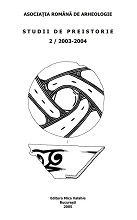Selective pollen destruction in archeological sediments at Grădiştea Coslogeni (Călăraşi county, Romania)
Selective pollen destruction in archeological sediments at Grădiştea Coslogeni (Călăraşi county, Romania)
Author(s): Alexandru Mihail Florian TomescuSubject(s): Archaeology, Physical Geopgraphy
Published by: Editura Cetatea de Scaun
Keywords: archeological sediments; Cernavoda culture; Coslogeni culture; Holocene; pollen analysis; pollen preservation.
Summary/Abstract: The archeological site of Grădiştea Coslogeni is located on an ancient alluvial bar in Balta Borcei. A large island encompassed by two arms of the Danube River, Balta Borcei is part of the river floodplain. The stratigraphy of the site comprises deposits attributed to several periods: Neolithic, Eneolithic to Bronze Age transition, late Bronze Age, Iron Age, Pre-feudal and Medieval. Pollen analyses were previously carried out at Grădiştea Coslogeni by E. Spiridonova (1995). Based on results from eleven samples, she inferred that during the Hamangia occupation (Neolithic, approximately 5000–4600 BC; C. Bem, pers. comm.), the regional vegetation was represented by Poaceae (Gramineae) and Artemisia (mugwort) steppe with rare Quercus (oak) and Fraxinus (ash) groves, and with isolated trees in the vicinity of the Danube. She noted an increase in number of the trees for the second part of the Hamangia period. The Eneolithic – Bronze Age transition period, (Cernavoda; somewhere between 4000–3000 BC) was also characterized by steppe vegetation, but trees were more numerous. As for the Coslogeni period (late Bronze Age, approximately 1400–1250 BC), the author described a steppe vegetation witnessing a progressive thinning of the arboreal vegetation. However, the low pollen sums recovered in these analyses, as well as the dominance of Poaceae, Chenopodiaceae and Asteraceae pollen in all samples, suggest poor pollen preservation, questioning the reliability of such reconstructions of the regional vegetation – as demonstrated by M. Tomescu (2000). Although absolute pollen frequencies are quite high in the four samples, poor pollen preservation, as well as the evidence of selective destruction of organic matter including pollen, render impossible the taxonomic identification of palynomorphs in three of the samples (samples 2–4) and forbid any interpretation of sample 1 in terms of regional vegetation. It is nevertheless worth mentioning that the five arboreal pollen grains identified taxonomically correspond to five different genera, which points to the taxonomic diversity of the arboreal vegetation. Information yielded by the four samples analyzed at Grădiştea Coslogeni raises once again the problem of the reliability of results coming from pollen analyses carried out in such sediments, as means of reconstructing the vegetation.
Journal: Studii de Preistorie
- Issue Year: 2004
- Issue No: 2
- Page Range: 181-186
- Page Count: 6
- Language: English

